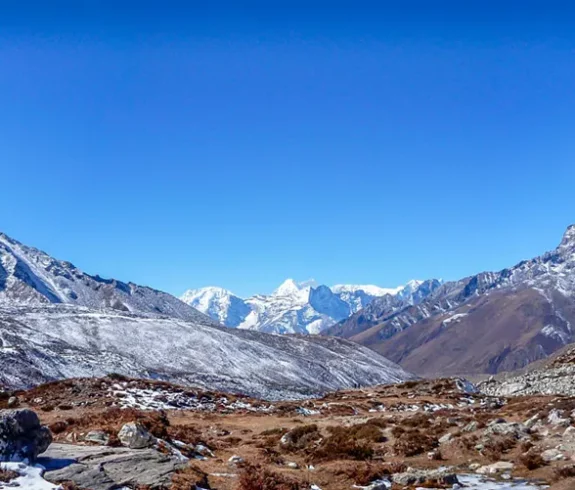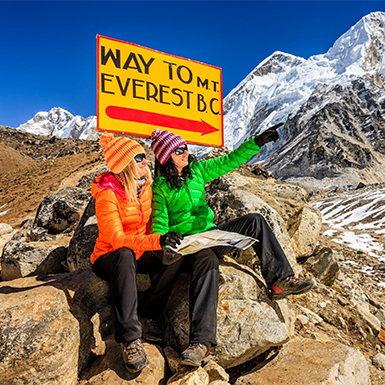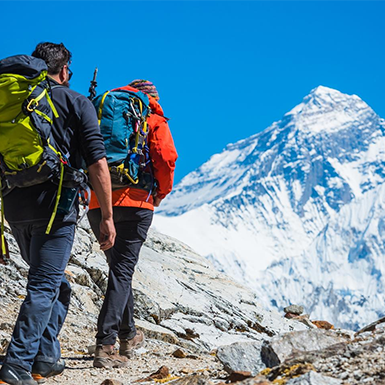Mt. Everest, the king of all mountains, has fascinated people’s imaginations worldwide. The first attempt at its summit was made in 1922 A.D. it was unsuccessful, but that couldn’t stop people from dreaming about conquering the world’s highest mountain. Since the successful exploits of the legends Edmund Hilary and Tenzing Norgay in 1953, Mt. Everest has become a reality. It is no longer shrouded in myth and mystery.
Encouraged by their success, thousands have followed suit, and many have succeeded, but many have failed and sacrificed their lives during their attempts. But today, the Mount Everest Base Camp Trek, also known as EBC Trek, has made it possible for everyone who wants an up-close view of Everest. Currently, it is the most adventurous, challenging, and exciting trekking destination in Nepal and the entire world, leading you straight to the lap of the legendary Mt. Everest.
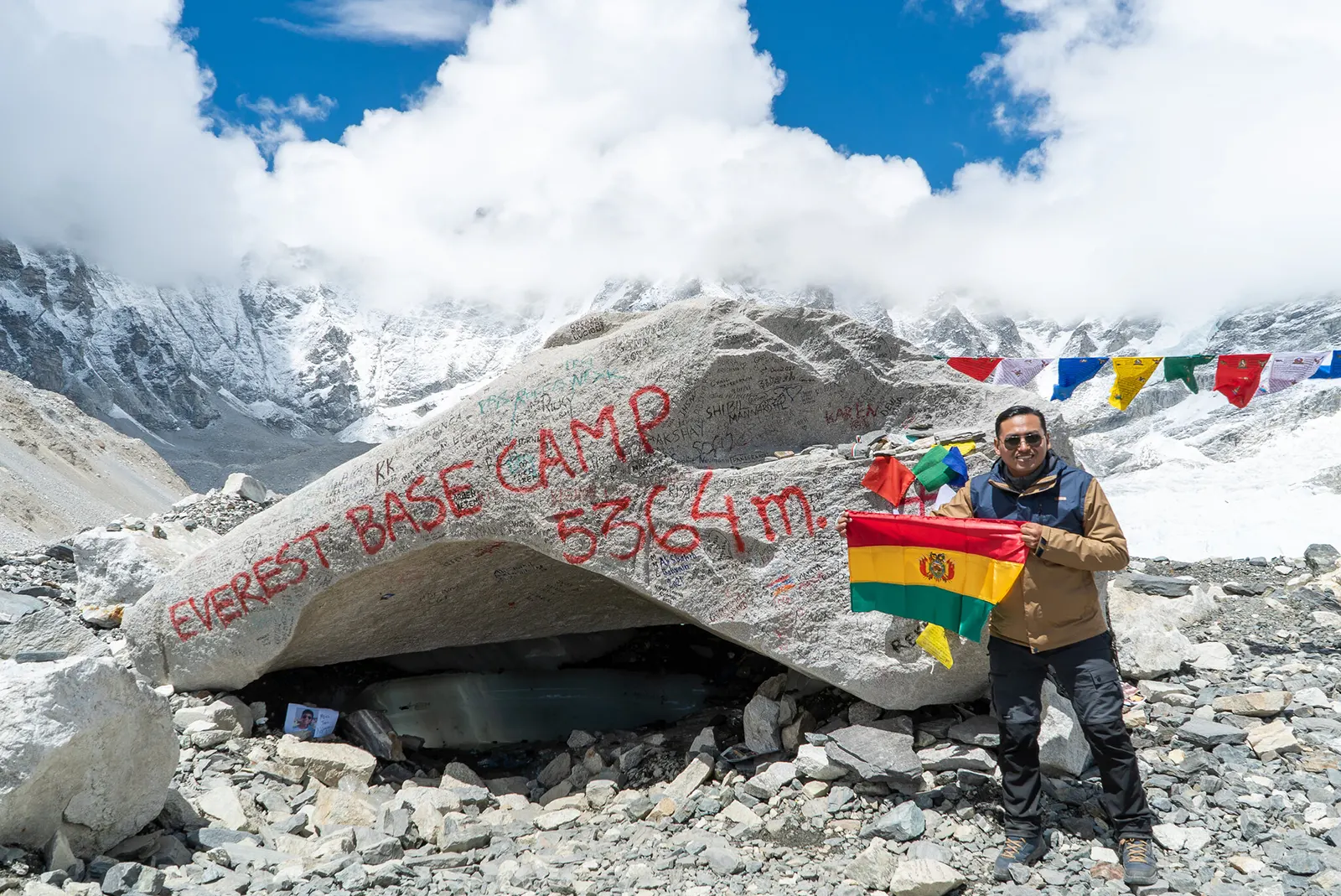
This adventurous journey to the base camp tops the bucket list of all the trekkers and adventure seekers worldwide and takes you on a roller coaster ride. Likewise, the most majestic panoramic views of the Himalayas provide the perfect setting for dreamlike trekking with an outworldly experience that encourages experienced travelers to indulge in the adventure of a lifetime. Thus, the Mount Everest Base Camp Trek blends the Himalayan scenery, exotic mountain culture, and the ultimate sense of adventure.
This Everest Trekking provides an unforgettable experience of the most magnificent panoramic views of the Himalayan chain of the Khumbu region, which consists of five of the world’s highest mountains that are Mt. Everest (8848 m), Mt. Makalu (8463 m), Mt. Cho Oyo (8153 m), Mt. Lhotse (8501 m), and Mt. Lhotse Shar (8,393 m). Also, rich pine forests of rhododendrons and various engendered flora and fauna enhance the Mount Everest Trek. That makes the trek genuinely memorable and exhilarating once-in-a-lifetime trekking extravaganza.
Mount Everest Base Camp Trek also provides an incredible opportunity to enlighten yourself with the culture, heritage, and history of the world-renowned mountain the Sherpas, their peculiar lifestyle, and their unique culture. Hence, the two-week hike to Everest Base Camp starts and finishes off at Lukla, an airstrip in the south of the region that is popularly known as the gateway to Everest.
Trip Facts
- Geography: Himalaya
- Location: Sagarmatha Region
- Level of Difficulty: Hard
- Duration of Trek: 13 Day
- Max Altitude: Kalapatthar (5,545m)
- Religions: Buddhism/Hinduism
- Ethnic People: Sherpa
- Accommodation: Guest House/Hotel
- Transportation: Private Car/Bus/Flight
Highlights of Mount Everest Base Camp Trekking
- Visit the Sherpa Museum in Namche Bazar.
- I am exploring the settlement region of the Sherpas.
- Trek to the foot of the world’s highest mountain- Mt. Everest.
- Adrenaline-pumping scenic flight from Lukla airport.
- Explore UNESCO World Heritage Sites.
- Sandy plains of Gorakshep, the broad summit of Kalapathar (5545 m).
- Buddhist monasteries, the major attraction being the vast monastery of Tengboche, built in the 17th
- Unparallel views of Mt. Everest, Mt. Makalu, Mt. Nuptse, Mt. Lhotse, and Mt. Thamserku, among others.
- Spellbinding Khumbu Glacier and Khumbu Icefalls are the highest glaciers in the world.
- Panoramic view from Syangboche.
Geography of the Everest region
Mount Everest is located in the Eastern part of Nepal and serves as a border between Nepal and Tibet. It is almost 29,000 ft above sea level; as a result, the temperature can fall as low as -14 degrees. For this reason, Nepal has three distinct climatic zones, and it’s hardly surprising that the Everest base camp lies in the coldest of all the zones.
Mount Everest Base Camp Trek Itinerary
Day 1: Fly to Lukla (2840 m)and trek to Phakding (2610 m)
Lukla is also known as the ‘Gateway to Everest.’
The Mount Everest Base Camp Trek officially begins after arrival at Lukla from Kathmandu, which takes around 35 minutes. However, the flight is nothing less of an adventure, providing a panoramic thrill with magnificent aerial views of the eastern side of Kathmandu. Finally, you will land on the airstrip in Lukla, a single runaway firmly settled on a steep hill. High peaks and breathing fresh air will surround you. Afterward, you will walk along the mountainside, crossing a few suspension bridges over fast-flowing white rivers, which get scarier as you walk further. The sacred mountain Khumbila is perched at the end of the valley. Then, you can take a break at Ghat village, which provides an excellent view of Kusum Kangraru, which stands at 6,367 m. The trail gradually descends towards Phakding village afterward.
Day 2: Trek for 6 hours to reach Namche Bazar
Your next stop will be the Dudh Koshi River as you climb gradually. The view of Thamserku appears in the distance after walking for about half an hour. The rough trail swings up and down and crosses the suspension bridge numerous times. Finally, you will arrive at the settlement of Jorsale after 2 hours of walking, which has a few teahouses and the Sagarmatha National Park entry post, where you will register your permits. Hence, this is the last stop where you can purchase food items and water until you reach Namche after 3 hours.
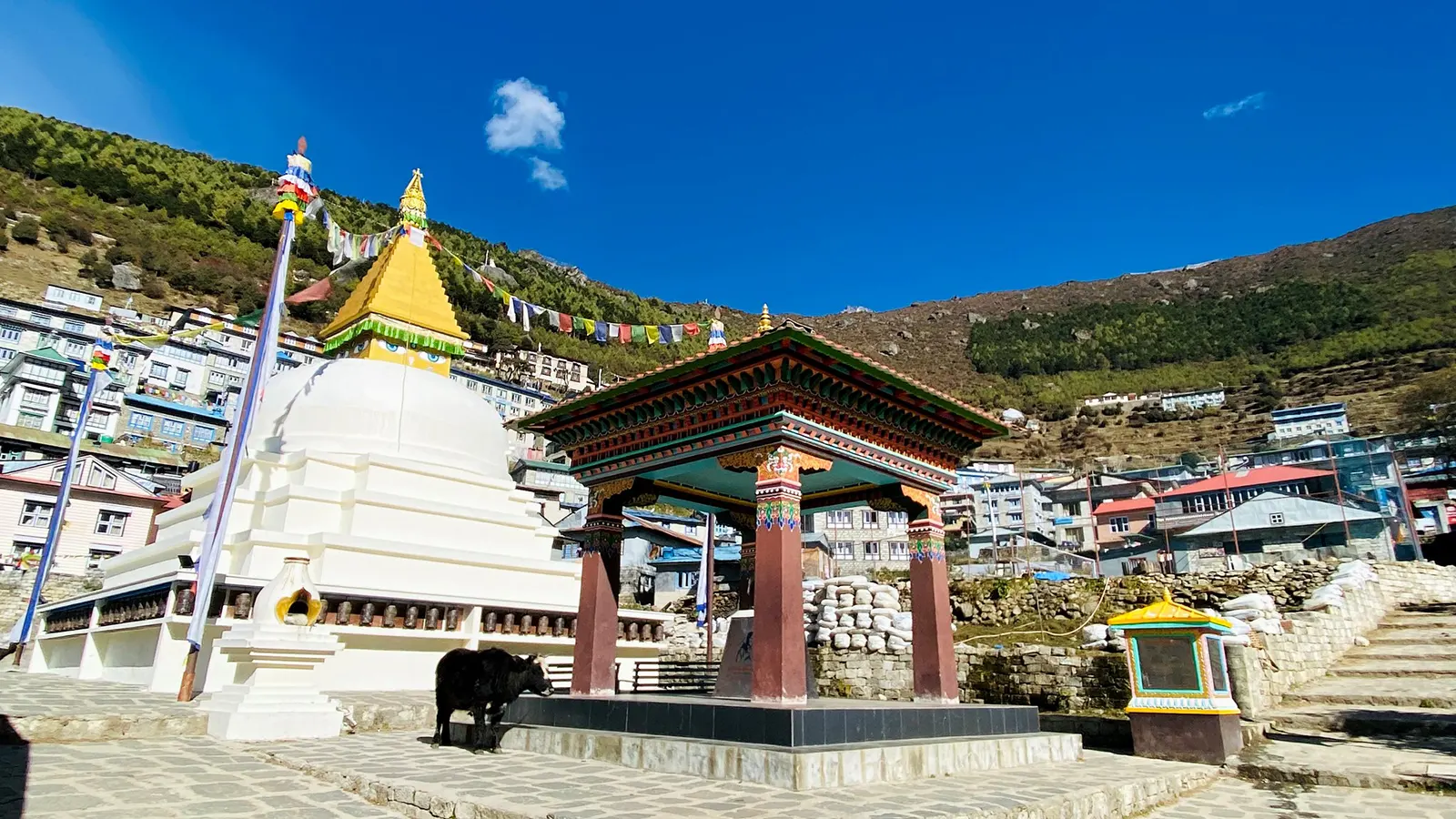
The trail leads further north to the confluence of DhudKoshi and Bhotekoshi and crosses over one of the scariest suspension bridges. For the next 2 hours or so, you will be climbing through the dense forests of cedar, pine, and lush rhododendrons as you head to Namche Bazaar. Then, the climb becomes very strenuous as the air begins to thin out. However, you will get the first glimpse of Everest and many other peaks. The famous Namche Bazaar is perched on the mountainside, offering majestic views of Kongdi Ri and Thamserku.
Day 3: The day for resting and acclimatization
Namche is the largest town in the Khumbu region. It is a famous commercial center because of its strategic position at the gateway of Tibet and the other two valleys to Gokyo and Everest base camp. Namche is the ideal place for acclimatization and also consists of numerous cafes and restaurants with Wi-Fi connections, souvenirs, and trekking gear shops. Then, hiking 15 minutes to the ridge at 3800 m early in the morning gives you a feast of the spectacle of the mountains and the panoramic view of Mt. Everest, Ama Dablam, and other peaks.
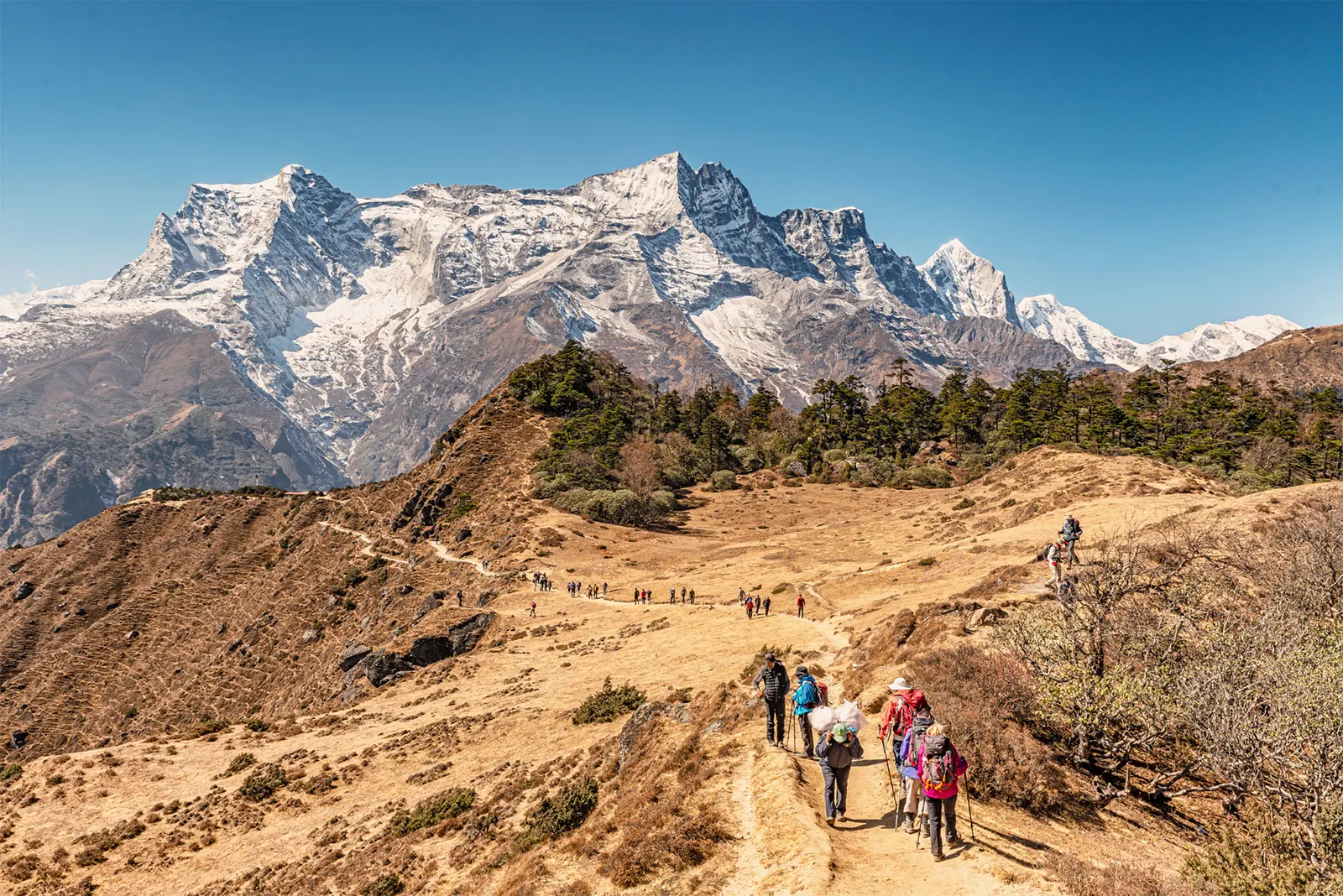
You can also opt for an additional hike to Sagarmatha National Park and a memorable visit to Hilary School. An hour away from Namche Bazar leads you to a historical Sherpa settlement whose old immense pride is in their culture, traditions, lifestyle, and famous buttery milk scope.
Day 4: Trek to Tengboche Monastery
The trail from Namche bazaar stretches towards the mountainside, where you will come above the tree line with shrubby vegetation, offering a pristine and uninterrupted view of Everest. Then, the climbing descends to the Dudh Koshi River from PhortseTenga village. Then, the climbing ascends on the other side to the ridgetop, marked by the Tengboche monastery, and offers one of the best views of the Himalayan corridor with Mt. Everest and other fall mountains into the Khumbu region. Tengboche is the biggest monastery in the area, situated at 3,867 m, and is nestled in unique landscapes. It also provides a serene 360-degree mountain view with a peaceful ambiance.
Day 5: Trek to Dingboche
After enjoying the magnificent sunrise over Amadablam, the journey continues toward Dingboche. The trail from Tengboche trails descends towards the luxurious rhododendron forests to the end of the Debuche village, crossing the deep gorge over the suspension bridge. Ascending towards Pyangboche village leads to an open pasture, giving an elegant vista of the Amadablam and the Lhotse. After crossing the town of Shomare, the trail leads us to the confluence of the Dudh Koshi and Imja Khola rivers. Upon crossing the river, the trail follows the Imja Khola, which goes to Dingboche. The path on the left side goes to Pheriche, where the Himalayan Rescue Association operates a health check post. Both routes eventually meet at Dough La.
Day 6: The day for resting and acclimatization
Dingboche is ideal for acclimatization as the altitude is above 4000m. Various things can be done to make the acclimatization day fruitful. The first option is to climb Nagarjuna Hill (5050m), a famous viewpoint in Dingboche. It offers magnificent views of Ama Dablam (6812m), Makalu (8485m), Cho Oyu (8201m), and many more. As the trekkers are advised to hike to a higher altitude during acclimatization day, climbing Nagarjuna Hill is the best option. Besides that, there is a second option, which is to walk to the village of Chukhung. Explore the town and return to Dingboche for lunch.
Day 7: Trek to Lobuche
The trail from Dingboche heads to the end of the pasture, climbing to Dhungla, which has a few lodges. The strenuous climb continues to the ChupkiLhara, marked by prayer flags, memorials, and stone carvings. This stop also gives the first glimpses of the snowcapped mountains like Pumori, Khumbutse, and Lingren at the end of the valley. The trail here descends, following Khumbu glacier’s moraine to Lobuche, a small valley with few teahouses. During the trek to Lobuche, you can enjoy the vistas of the spectacular mountains.
Day 8: Trek to Gorakshep and hike to Everest Base Camp
The high altitude takes a toll and makes you slow despite the short distance. It is advisable to go slower for acclimatization and enjoy the scenic beauty. The show-capped mountains will dwarf you, looming all around you. You will follow the glacial Morane and rockery next to the Khumbu glacier, the highest glacier in the world. Gorakshep is only about two and a half hours away from Lobuche.
Continuing your journey to the base camp will lead you to the Army Mountaineers Memorials. You will be trekking further to the Everest base camp at the end of the valley. This is the closest you will ever be to the iconic Everest. The exquisite Mt. Everest soars high against the background of the deep blue sky. The cold breeze of Everest on the base camp leaves you with a nostalgic feeling. You can click pictures to commemorate this incredible feat. You will feast on the panoramic sights of Khumbu Icefall and its towering seracs, Pumori, Lhotse, and other majestic peaks, and head back to Gorakshep for the night.
Day 9: Hike to Kala Patthar and trek back to Pheriche.
The early morning trek to Kala Patthar, which stands at 5,550 m, offers an up-close view of Mt. Everest and other snow peaks like Lhotse and Pumori, with an overview of the Everest base camp. After returning to Gorekshep, you descend through the same trail via Lobuche and Dugha La. After Dugha La, you will take the trail on our right to Pheriche instead of going to Dingboche, where we spent two nights while coming up. Pheriche is a small settlement on the left bank of the Dudh Koshi River.

Day 10: Trek back to Namche
Following the trail you moved through, you will be heading towards the Tengboche monastery and down to Namche Bazaar. The walk back allows you to revisit earlier memories of the breathtaking Himalayan vistas. So, stroll to enjoy all the majestic beauty surrounding you, eager to share your tales of the most classic and legendary adventure.
Day 11: Trek back to Lukla
Today is the final day of this breathtaking Mount Everest Base Camp Trek. After breakfast at Namche Bazaar, descend to the river confluence and Jorsalle and continue our walk toward Monjo, where we must show our permits. Crossing Monjo, continue through Bengkar, Phakding, and Ghat villages before climbing to Cheplung and Lukla.
Day 12: Fly back to Kathmandu
You will be overwhelmed by bringing this epic journey to an end. The scenic flight from Lukla to Kathmandu is scheduled for early morning to avoid the strong winds. You will leave with a heart filled with pride and beautiful memories.
Best trekking seasons for Mt. Everest Base Camp Trek
Before settling on the journey, the base camp area’s harsh weather and climate conditions must be considered. The trekking is open for the entire year, but the ideal time for Mount Everest Base Camp Trek is from March to May and September to December. Avoiding the winter months is better, as the heavy snowfall will cause hindrances in navigating the rugged region. The visibility is poor during the rainy season as the majestic mountains are lost behind the clouds.
Mount Everest Base Camp Trekking Permit
You will need to have two trekking permits for Everest Base Camp Trek. One is the TIMS (Trekkers Information Management System) card, and the other is the Sagarmatha National Park entry permit.
The difficulty level of Mount Everest Base Camp Trek
Trekking in the Everest region is challenging because of the high altitude involved. It is a highly challenging trek that can be conquered with determination and good training. EBC trekking consists of walking up to 8 hours a day. You are highly advised to maintain a slow pace and enjoy the view of the mountains. Slow and steady is the best practice to enjoy and conquer this Everest trek. You need both physical training and mental strength to overcome the challenges and difficulties of this journey. Having previous trek experiences will also ease your experience.
Hiking on the legendary foothills just below the gigantic Mt. Everest provides stunning views. For anyone, those views are like a dream come true. It is widely renowned for its trailblazing routes and breathtaking landscapes that awaken your senses.
Final thoughts
The Mount Everest Base Camp Trek will push you beyond your pain, discomfort, and fatigue and give you a sense of accomplishment as you emerge victorious, surpassing all the odds against you. The ethereal beauty and the magnificence of nature surrounding Everest will saturate your soul.
Enriched in the long history of legacy, glory, and tragedy, EBC trekking fulfills your dreams of touching the feet of Mt. Everest, leaving you with unforgettable memories and experiences lasting a lifetime and legendary stories worth passing on to generations.
Please get in touch with us if you have any questions or queries regarding this trek or any other trek in Nepal.
